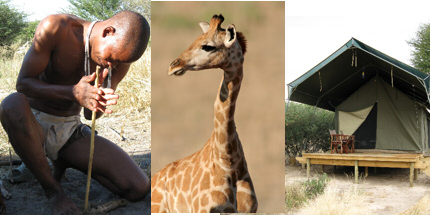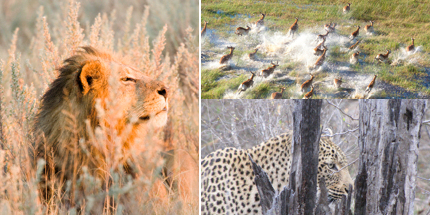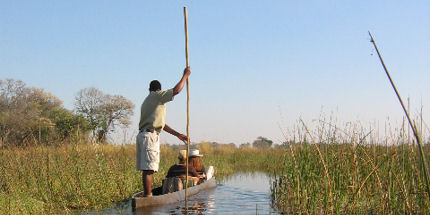Botswana: A tale of two safaris
From lion-tackling to hunting with bows and arrows, ancient traditions still endure across wildlife-rich Botswana. Lesley Stones journeys to the sprawling Kalahari and flooded Okavango Delta for two spectacular safaris, minus the crowds.
By the time Jooster Mokgapwe sits back and gives a weak grin of defeat, his hands are blistered.
“No woman for me,” he says glumly, dropping the sticks he was manically rubbing together on a heap of dried grass and twigs. He’s failed to create a fire using friction, a traditional test among Kalahari Bushmen which means he may not win the right to marry his prospective bride.
But at least he will be spared from the far more dangerous task of chasing a lion away from its kill, and triumphantly hauling home the carcass to impress his intended father-in-law.
Jooster is one of Botswana’s 230 surviving bushmen still living in the Central Kalahari Game Reserve. In total, only 100,000 bushmen remain, scattered throughout Southern Africa.
As he wields his savage hunting axe, you just know this baby-faced, 23-year-old has never clubbed anything to death. Instead he educates guests at Kalahari Plains, a lodge run by Wilderness Safaris, in what his ancestors call “the thirsty land.”
 Bushman Jooster and the Kalahari Plains Camp
Bushman Jooster and the Kalahari Plains CampiStockphoto / Thinkstock and Lesley Stones
Jooster puts on an intriguing display of traditional hunting and survival skills, his skinny body all wiry energy. He’s clad in a kudu skin loincloth and a fur headdress topped with mini antlers, but at the end of his performance, he strips off to pull on ordinary jeans and a t-shirt.
A walk on the wild side
Kalahari Plains is a remote, rustic, stilted lodge with 10 en-suite canvas bedrooms, a small swimming pool, lounge and dining room. Solar power provides electricity and hot water. Guests enjoy dawn and dusk game drives, and return to delicious meals that defy the sparse surroundings.
Many of the staff are descended from the bushmen, whose traditions still endure. Before Jooster guides me on a Bushman’s Walk, we invoke the spirits of our ancestors. We each take a stick, drop it in front of us and jump over it, asking the spirits to lead us to a kudu. Since my ancestors wouldn’t know a kudu from a koala, I fear we may go hungry.
His satchel is crafted from steenbok skin, softened by rubbing with a gory mixture of antelope brains and fat. Inside are tools straight from The Flintstones. His axe is a concession to modernity with a metal blade instead of the traditional sharpened kudu rib. That’s handy for slaying animals, building a shelter, or breaking into a beehive to steal honey. His bow and arrow are made lethal by dipping the tip in a cocktail of saliva and fluid extracted from insect larvae. Once an animal is darted, the bushmen may track it for up to 24 hours until it succumbs, or axe it to death if they catch it. It’s all brutal stuff, but explained with the sweetest baby-faced grin.
We walk on, and I clap with delight when I spot Jooster’s tiny tribal hut made from woven grass. To fend off snakes, the ground outside is liberally doused with stinky fluid extracted from the anal gland of a honey badger. That’s not something a honey badger relinquishes easily, and they’re notoriously vicious fighters. “It’s a simple animal to kill with my digging stick,” says Jooster. “Hit it right on the nose and it faints.”
For a fascinating finale, he sets a trap to catch guinea fowl that scavenge through the scrub. With deft hand movements, he rigs up bits of string around branches bent over a succulent berry. Mimicking a pecking bird, he gently touches the berry with a stick. Pow! The stick yanks from his hand and flies upwards, bobbing around like a bird with a broken neck. It’s impressive stuff. Jooster should win his woman after all.
 Botswana offers rich wildlife viewing for safari-lovers
Botswana offers rich wildlife viewing for safari-loversiStockphoto / Thinkstock and Lesley Stones
Floods of life
The Central Kalahari Game Reserve spans five million hectares of savannah that support black-maned lion, leopard, cheetah, giraffe and a wide range of antelopes. It’s a stark, barren place until rain brings the land to life again, transforming the sandy ground as grasses sprout and broken shrubs miraculously regenerate. The new life attracts the hungry grazers, attracting even hungrier predators in their wake. But the soil sucks up the water greedily, and once the rains end, the greenery quickly withers, leaving the land scorched and stark again. It’s Africa at its most raw and unforgiving, with the safari lodges providing a delicious touch of luxury in the wilderness.
In contrast to this endless brown nothingness is the Okavango Delta, an hour’s flight away, which takes me into a completely different world. From the window of my Cessna, I see large, healthy trees surrounded by water. Everything is lighter, brighter, more alive.
Tubu Tree Camp stands on Hunda Island amid floodplains that act as one enormous watering hole. Each of Tubu’s five tents, perched on wooden platforms, are sturdy structures with double beds, wardrobes, bathrooms and stunning vistas; chances are, you’ll spot a passing elephant as you sponge down in the outdoor shower.
The knee-deep lagoons and channels around islands of rich savannah sprawl for about 6,000 sq miles and teem with giraffe, zebra, monkeys and endless antelope. On an evening game drive, we stop at a mighty termite hill where a young leopard lifts his head and gives us a cursory glance. Then with a single indefinable movement, his entire body tenses from an idle lump of fur into a streamlined killer. Something has piqued his interest, and in a blink he slips into the undergrowth.
Surpassing this is my mokoro boat trip. I’m closer to the water than the spider webs that skein across my face as my guide Joseph punts me through the reeds.
 Mokoro safari trips in the Okavango Delta
Mokoro safari trips in the Okavango DeltaLesley Stones
The peace is astonishing; the only sounds are buzzing insects and the distant trumpeting of an elephant. Joseph is small and slight, with a timeless face which makes it impossible to tell his age. He could be 30 or 300. He tells me I should meet his uncle, who is scarred from head to toe by lion claws. His advice if I come face-to-face with a lion? Run towards the lion, flap your arms and make as much noise as possible to prove you’re the more aggressive beast. The lion will be so intimidated, it will turn and flee, Joseph promises.
I mull this over as I watch the moon rise over the delta in a vivid ball of red. I detect a flaw in the lion-tackling theory. What if you run closer only to realise the lion is standing his ground? Ah yes, Joseph admits, it only works about 60% of the time. Just ask Uncle Scar-Face.
Where to stay:
Wilderness Safaris (+27-11-807-1800; www.wilderness-safaris.com) offers three nights at either Kalahari Plains Camp or Tubu Tree Camp from around £735pp (based on two sharing), including transfers from Maun airport, daily activities and all meals (excluding drinks).
When to travel:
The Kalahari is cool and dry in September and October, when sparse vegetation can make game viewing limited. Rains come in dramatic summer thunderstorms between November and April, transforming the landscape within days and making game viewing far more rewarding. But the heat can be intense with temperatures reaching 40°C.
The Okavango Delta is a year-round destination. Canoe safaris are best when the waters peak in May and June but hot and dry September and October are also good for game viewing. Rains between November to April are good for bird watching rather than game viewing.
Insider tip:
Lodges typically hike their rates by 30-40% in the peak period between June to October, making longer stays more affordable from November to May.
Do you have any Feedback about this page?
© 2025 Columbus Travel Media Ltd. All rights reserved. No part of this site may be reproduced without our written permission, click here for information on Columbus Content Solutions.









 You know where
You know where